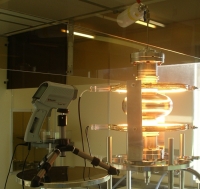 |
 |
|||||||||||||
|
|||||||||||||
|
|||||||||||||
|
Before accelerating electrons and positrons, cavities need to undergo a number of treatments, such as chemical and electropolishing, the last one being baking. The standard baking procedure heats the cavity at 120°C for two days with an ultra high vacuum (UHV) requirement. These very restrictive conditions are unfortunately not appropriate for the treatment of 16,000 cavities that the ILC requires. This work ensues from the discovery, at Saclay, of the necessity for baking cavities under vacuum to suppress the high field Q-drop (quality factor drop) (see figure 1) and thus improve cavity accelerating gradients. Saclay scientists presented this result at the European Particle Accelerator Conference (EPAC) conference in 1998. Since that time, engineers have used baking to suppress the original Q-drop in all types of cavities, such as TESLA, Ichiro, “Low-Loss” and Re-Entrant shapes. As for electropolishing (see 15 March issue of NewsLine), engineers learn from their tests what makes a good “recipe” for a cavity without knowing exactly the theoretical reasons why it works. They do know, however, that baking affects the superconducting properties of niobium. At Saclay, they proposed two main changes to simplify the baking procedure taking into account that the oxygen diffusion, from cavity surface or oxide-metal interface, should be avoided during cavity treatment. The first one is to shorten baking time by increasing the temperature, for the same consequence on Q-drop removal but without any change in terms of oxygen diffusion. The second is to avoid the constraint of working under ultra high vacuum, which implies the assembly of cavity with flanges and gaskets. Instead, Saclay scientists proposed to work on a cavity open-ended under argon, an inert gas. During a monthly Tesla Technology Collaboration videoconference meeting at the end of February 2007, Bernard Visentin, the head of the Saclay baking team, presented the new result. The Saclay team compared similar single cell cavities, electropolished and tested DESY, after baking them in two different situations. At Saclay, the cavity was heated under argon, at 145°C during 3 hours. At DESY, the cavity was heated with the classical procedure: under ultra high vacuum, at 130°C, during 48 hours. They both obtain the same results of about 36 MV/m with the same Q-drop removal (see figure 2). “This new procedure will really simplify and shorten the cavity treatments,” said Visentin. “It is essential now to go further if we want to make it feasible for the industry”. At Saclay, the team obtained another improvement using an infrared heating source (see image 3) instead of wire-resistances. This source reaches, without cavity contact, very quickly the desired temperature, of 145°C in about 5 minutes. When you are trying to reduce the baking time to a few hours, this parameter becomes crucial. To try to understand the yet unknown physics phenomena which happen during cavity baking, the next step is to know if the baking process is possible in only one hour. Extrapolating that 60 hours of heating under 110°C gives the same effect as three hours at 145°C, engineers estimate that they could reduce the baking to one hour if they succeed to heat the cavities at 160°C. Baking cavities at this temperature is not an easy task though. At Saclay, they are now building new equipment to test a baking procedure under argon at this higher temperature with an open-ended cavity. -- Perrine Royole-Degieux |
|||||||||||||
| © International Linear Collider |


